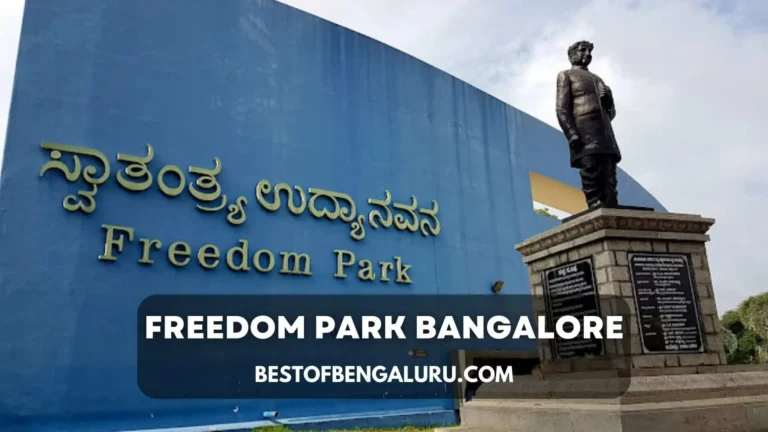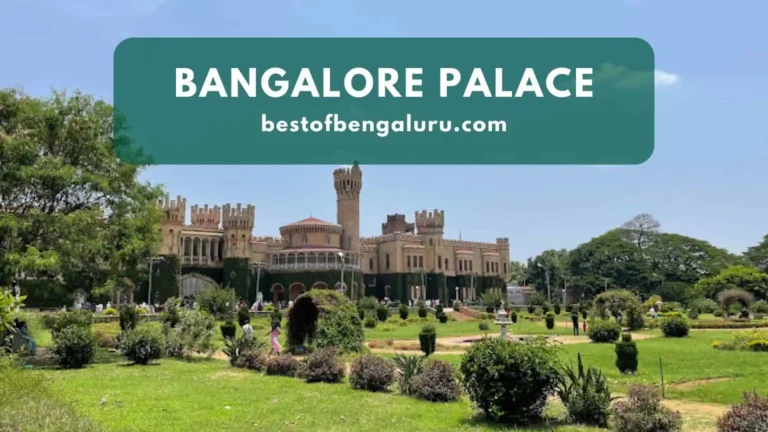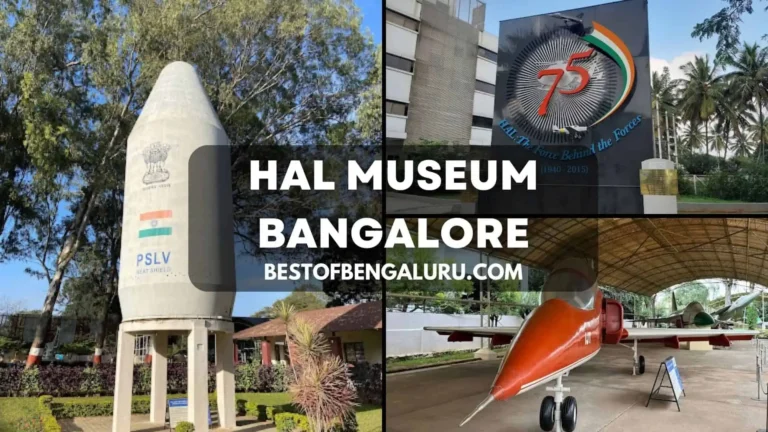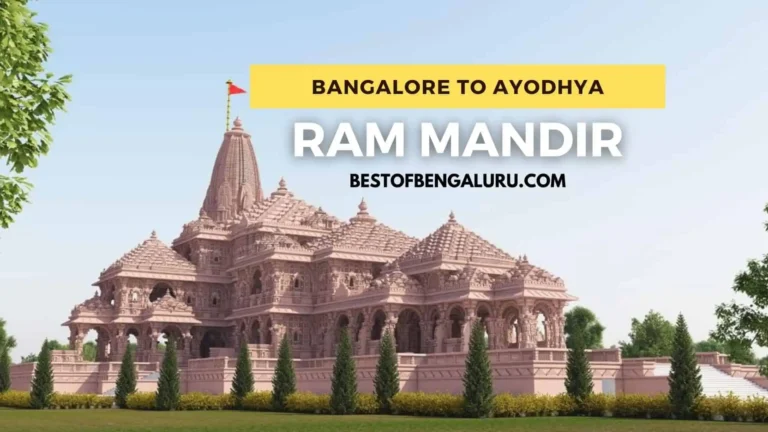Devanahalli Fort Timings, Entry Fees, History, How to Reach
If you are looking for a historical and cultural destination near Bangalore, you might want to visit Devanahalli Fort. This fort is not only a remarkable example of ancient architecture but also the birthplace of one of the most famous rulers of India, Tipu Sultan.
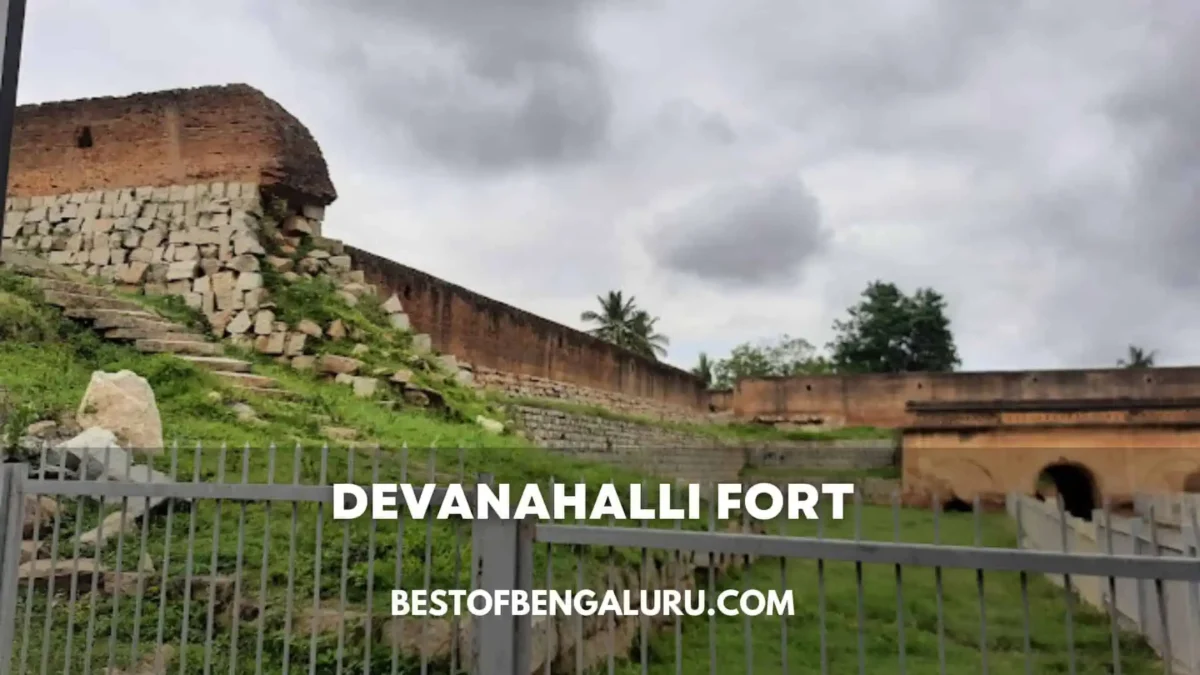
In this blog post, we will explore the Devanahalli Fort timings, entry fees, history, and how to reach it from Bangalore.
Consider reading: 27 Unique Places to Visit in Bangalore For Couples, Family and Friends
Devanahalli Fort Timings and Entry Fees
Devanahalli Fort is also a marvel of architecture, with 12 semi-circular bastions, ornate entrances, and several temples within its premises.
Devanahalli Fort Timings
Devanahalli Fort is open to the public every day from 6:00 AM to 10:00 PM. This means you have plenty of time to explore the fort and its surroundings at your own pace. You can also witness the fort in different lights, from the morning sun to the evening glow.
The best time to visit Devanahalli Fort is during the winter months, from November to February when the weather is pleasant and dry.
Devanahalli Fort Entry Fees
The entry fee to Devanahalli Fort is very nominal and affordable. For Indian tourists, the entry fee is INR 25 per person, while for foreign tourists, it is INR 300 per person.
There is no separate fee for children or senior citizens. The entry fee is collected at the main gate of the fort by the Archaeological Survey of India (ASI), which is responsible for the maintenance and preservation of the fort.
Consider reading: Best Places to Visit for One Day Trip from Bangalore within 50, 100 and 200 KMs
History of Devanahalli Fort
Construction of the Fort
- Built in the 15th century, Devanahalli Fort holds a significant place in the history of Karnataka, India.
- It was constructed by Mallabairegowda, a local chieftain, as a stronghold against external invasions.
- The fort’s architecture showcases the brilliance of Dravidian and Indo-Islamic styles, blending both Hindu and Muslim design elements.
Rulers of Devanahalli Fort
The Devanahalli fort changed hands multiple times throughout history. Some of the notable rulers were:
- Kempegowda I: The founder of Bangalore, he captured the fort in the early 16th century.
- Hyder Ali: The de facto ruler of the Kingdom of Mysore, he took control of the fort in the 18th century.
- Tipu Sultan: Known as the “Tiger of Mysore,” he further developed and fortified the fort during his reign.
The fort witnessed several important events that shaped the region’s history, including:
- Birthplace of Tipu Sultan: Devanahalli Fort is the birthplace of Tipu Sultan, the famous ruler of the Kingdom of Mysore.
- Siege and Capture by the British: In 1791, the fort was besieged by the British East India Company during the Third Anglo-Mysore War, leading to its capture.
- Contribution to Indian Independence: Devanahalli Fort served as an important base for Indian freedom fighters during the struggle for independence from British rule.
The history of Devanahalli Fort is intertwined with the rich world of Karnataka’s past. Its construction, various rulers, and significant events make it a must-visit destination for history buffs and those seeking to explore unique places in Bangalore.
Consider reading: Freedom Park Bangalore Timings, Entry Fee, How to Reach by Bus, Metro, and Things to Do
Architecture of Devanahalli Fort
Main Entrance and Gateway
- The main entrance of Devanahalli Fort is an imposing structure that showcases the blend of Dravidian and Indo-Islamic architectural styles.
- The entrance consists of a grand gateway with intricately carved motifs and designs.
- The fortification walls surrounding the entrance are built using large granite stones, providing a strong defense against invasions.
- The arched entrance is adorned with decorative patterns and sculptures, reflecting the artistic craftsmanship of the time.
Palace and Residential Area
- The palace within Devanahalli Fort served as the residence for the ruling dynasties and nobles.
- The architecture of the palace is a testament to the rich cultural heritage of the region.
- The palace comprises of multiple courtyards and ornate halls, each showcasing a unique architectural style.
- The residential area within the fort includes halls, kitchens, and living quarters for the royal families and their attendants.
- Devanahalli Fort is home to several temples and shrines that hold religious significance.
- The Venugopalaswamy Temple is one of the prominent temples within the fort, dedicated to Lord Krishna.
- The temple architecture displays intricate carvings and sculptures, depicting episodes from Hindu mythology.
- Other shrines within the fort complex include those dedicated to Ganesha and Durga.
Devanahalli Fort stands as a testament to the architectural prowess of its builders and the historical significance of the region. Its main entrance and gateway, palace and residential area, and temples and shrines all provide a glimpse into the rich cultural heritage of Karnataka. Exploring these architectural wonders within the fort is a must for anyone seeking to investigate into the past and witness the unique blend of Dravidian and Indo-Islamic styles.
Role of Devanahalli Fort in Indian History
The Devanahalli Fort holds immense historical significance in Indian history. Let’s explore its role in shaping the region’s past with a focus on Tipu Sultan and the siege and capture of the fort.
Tipu Sultan and Devanahalli Fort
One of the most notable connections to the fort is Tipu Sultan, the fierce ruler of Mysore. The fort holds the distinction of being the birthplace of Tipu Sultan, who was born here in 1750. He went on to become one of the most prominent figures in Indian history, known for his resistance against British colonial rule.
Siege and Capture of Devanahalli Fort
The Devanahalli Fort faced several invasions and sieges throughout its history. During the reign of Hyder Ali, Tipu Sultan’s father, the fort was besieged and captured, marking a significant event in the region’s history.
Here are a few key points about the siege and capture of the fort:
- The British East India Company, with an aim to expand its dominion in South India, laid siege to the fort in 1791.
- Even though the valiant efforts of Tipu Sultan and his army, the fort fell into the hands of the British, who seized control of it.
- The capture of Devanahalli Fort by the British was a crucial step in their consolidation of power in the region.
The historical accounts surrounding the siege and capture of Devanahalli Fort provide us with invaluable insights into the struggles and conflicts that took place during that era.
Devanahalli Fort’s significance in Indian history cannot be overstated. Its association with Tipu Sultan and the events surrounding the siege and capture exemplify its role as a witness to the challenges and triumphs that shaped the region.
Continue reading the article to discover more about the architecture and hidden stories of this remarkable fort in Karnataka.
Restoration and Present Condition of Devanahalli Fort
Restoration Efforts
Over the years, there have been significant restoration efforts made to preserve the Devanahalli Fort and ensure its historical significance is maintained. These restoration initiatives aimed to revive the fort’s architectural grandeur and showcase its rich heritage to visitors. Some key restoration efforts include:
- Repairing and Reconstruction: Dilapidated structures within the fort were repaired and reconstructed to bring back their original charm. Skilled craftsmen were employed to carefully restore the intricate carvings and artwork, ensuring that the fort maintains its historical authenticity.
- Conservation of Artifacts: Valuable artifacts found within the fort were meticulously conserved and displayed, providing visitors with a glimpse into the past. These artifacts include ancient weapons, pottery, and other relics that shed light on the fort’s cultural significance.
- Landscaping and Beautification: The surrounding areas of the fort were landscaped and beautified to enhance the overall visitor experience. Gardens, walkways, and seating areas were added, creating a serene and inviting atmosphere for tourists to explore.
Tourist Attractions at Devanahalli Fort
The Devanahalli Fort is not only a historically significant landmark but also offers several appealing tourist attractions. Here are some of the must-see highlights:
- Tipu Sultan Birthplace: The fort is renowned as the birthplace of Tipu Sultan, a brave warrior who fought against British colonization. Visitors can explore the exact spot where Tipu Sultan was born, gaining insights into his life and contributions to Indian history.
- Museum and Exhibits: The fort houses a museum that holds a vast collection of artifacts, documents, and artworks that depict the region’s history. Visitors can discover the intricate details of the fort’s architecture, learn about the battles fought within its walls, and understand the influence of Tipu Sultan on the area.
- Architecture and Design: The fort’s architecture is a fusion of Hindu and Islamic styles, showcasing the intermingling of cultures during that era. The elaborate carvings, intricate arches, and well-preserved structures offer an exceptional visual treat for history and architecture enthusiasts.
- Surrounding Scenic Views: Situated on a hillock, the fort offers breathtaking views of the surrounding countryside. Visitors can soak in the picturesque landscapes and capture memorable photographs.
Whether you are a history enthusiast, an architecture lover, or simply seeking a unique experience, the Devanahalli Fort is a must-visit destination. Its restoration efforts and captivating tourist attractions make it one of the best places to visit in Bangalore.
How to Reach Devanahalli Fort
When planning a visit to the Devanahalli Fort, it is important to know the best ways to reach this historical site. Here are some options to consider:
By Air
If you are traveling from a distant location, the quickest way to reach Devanahalli Fort is by air. The Kempegowda International Airport is located just 11 kilometers away, making it extremely convenient for travelers. Several domestic and international flights operate to and from this airport, ensuring easy access for tourists from all over the world.
By Road
For those who prefer road trips or are coming from nearby areas, there are well-connected roads that lead to Devanahalli Fort. The fort is situated approximately 35 kilometers away from the city center of Bangalore. You can choose to drive your own vehicle or hire a taxi or cab to reach the destination. The journey offers picturesque views of the surrounding countryside, making it a pleasant experience for travelers.
By Public Transport
Another convenient option is to use public transport to reach Devanahalli Fort. The Bangalore Metropolitan Transport Corporation (BMTC) operates regular buses from various parts of the city to Devanahalli. These buses provide a budget-friendly mode of transportation for visitors. Also, the nearest railway station to the fort is the Devanahalli Railway Station, which is well-connected to major cities in India.
Tips for Visitors
Here are some additional tips for visitors planning to visit Devanahalli Fort:
- Plan your visit during the morning or evening to avoid the scorching midday heat.
- Wear comfortable footwear as there may be some walking involved within the fort premises.
- Carry a bottle of water to stay hydrated throughout your visit.
- Don’t forget to bring your camera to capture the stunning architecture and scenic views.
- Follow all safety guidelines and regulations while exploring the fort to ensure a pleasant and safe experience.
By following these tips and considering the different transportation options, you can easily reach Devanahalli Fort and enjoy a memorable experience exploring its rich historical significance.
Consider reading: Nandi Hills: Timings, Entry Fee, Trekking, Height and How to Reach From Bangalore Via Train
Best time to Visit Devanahalli Fort
When planning a visit to the Devanahalli Fort in Bangalore, it is important to consider the best time to make the most of your experience. Here’s a breakdown of the ideal time to visit:
- Morning: The early hours of the day are the most pleasant and ideal for exploring the fort. The temperature is cooler during this time, providing a comfortable environment for sightseeing. Also, the natural light during the morning hours enhances the beauty of the fort and its surroundings.
- Evening: Another great time to visit the Devanahalli Fort is during the evening hours. The fort takes on a different ambiance with the setting sun, creating a picturesque view for visitors. The temperature during this time is relatively cooler than the scorching afternoon heat, allowing for a more enjoyable experience.
- Weekdays: If possible, plan your visit during weekdays to avoid crowds and enjoy a more serene atmosphere. Weekends tend to be busier, especially with local tourists, which may affect your overall experience. By visiting on weekdays, you’ll have more space and time to explore the fort at your own pace.
- Avoid Midday: As the midday sun can be quite harsh, it is advisable to avoid visiting the fort during this time, especially during the hotter months. The temperatures can soar, making it uncomfortable to walk around and explore the historical site. We recommend planning indoor activities or resting during the midday hours to escape the heat.
Remember to pack water and wear comfortable footwear while visiting the fort, as you may need to do some walking. By considering the best time to visit, you can ensure a more enjoyable and memorable experience at the Devanahalli Fort. Stay tuned for more insights into the fort’s architecture and attractions.
Final Thoughts on Devanahalli Fort
Heading to Devanahalli Fort? Here’s the lowdown to make your trip smooth and memorable.
First off, getting there is a snap from just about anywhere. If you’re flying in, the Kempegowda International Airport is only a stone’s throw away, a mere 11 kilometers. For those hitting the road or leaning on public transit, you’re in luck. Bangalore’s roads are well-trodden paths leading straight to the fort, and the Bangalore Metropolitan Transport Corporation keeps those buses rolling in regularly.
Timing’s everything for the perfect visit. Aim for the early mornings or late afternoons. That’s when the fort’s beauty truly shines, under a cooler sun and against a breathtaking backdrop. Weekdays are your best bet to dodge the crowds and the midday scorcher, making for a serene and easy-going exploration.
Don’t just show up; show up ready. Comfortable shoes are a must – you’ll be on your feet, discovering all the nooks and crannies. Keep a water bottle handy to beat the heat, and while you’re at it, stick to the safety guidelines. They’re there to make sure your adventure is as enjoyable as it is safe.
FAQs on on Devanahalli Fort
How can I reach Devanahalli Fort?
Devanahalli Fort can be reached by air, road, or public transport. The Kempegowda International Airport is only 11 kilometers away. There are well-connected roads and regular buses operated by the Bangalore Metropolitan Transport Corporation.
What are some tips for visiting Devanahalli Fort?
To make the most of your visit to Devanahalli Fort, plan your trip during the morning or evening to avoid the heat. Wear comfortable footwear and carry water. Follow safety guidelines to ensure a pleasant experience.
When is the best time to visit Devanahalli Fort?
The best time to visit Devanahalli Fort is during the morning or evening when the temperature is cooler, and the fort offers a picturesque view. It is also recommended to visit on weekdays to avoid crowds and the midday heat.
What can I expect to see at Devanahalli Fort?
Devanahalli Fort boasts a rich history, stunning architecture, and serene surroundings. It is a must-visit place in Bangalore for those interested in exploring the city’s heritage and culture.
Are there more insights into the fort’s architecture and attractions?
Stay tuned for more insights into Devanahalli Fort’s architecture and attractions. The fort’s rich history and remarkable features will be further highlighted, providing a deeper understanding of its significance.
